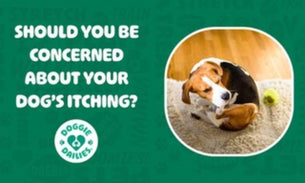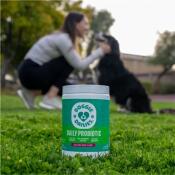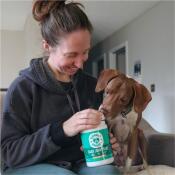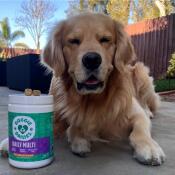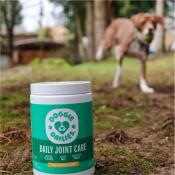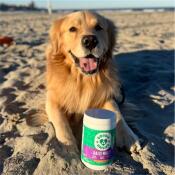Dog skin issues are one the most common reasons for vet visits. Dogs are prone to a variety of diseases that cause changes in your dog’s skin, including scaling, pustules, and lesions. Dog skin problems often lead to scratching and excessive licking. Unfortunately, this self-soothing can lead to the spread of skin infections and even self-harm.
Dog skin conditions are no fun and can make your dog very uncomfortable. Keep reading to learn more about common skin and coat problems for dogs and how to treat them.
How to Identify and Treat Common Dog Skin Problems
-
Canine Atopic Dermatitis
Canine atopic dermatitis refers to allergens that a dog may inhale. Just like humans, dogs suffer from environmental and seasonal allergies too! When lgE antibodies are exposed to environmental allergens, they can develop pruritic inflammatory skin disease. After inhaling allergens such as dust mites, mold, hair, and pollen, dogs experience discomfort and stress.
-
Symptoms of Canine Atopic Dermatitis
In the initial stages, dogs rub, scratch, and chew excessively. Depending on the allergen involved, this behavior may be seasonal. The itching and rubbing may occur in certain areas or the entire body. Due to allergic reactions, they may also develop some hot spots.
Canine atopy is different from a flea allergy, which affects the thighs, groin, and tail area. The disease is hereditary and is common in the following breeds;
- Boston Terrier
- Scottish Terrier
- Golden and Labrador Retrievers
- Fox Terrier
- White Terrier
- Dalmatian
- Boxer
- Shar-Pei
Usually, this disease occurs between 6 months and 3 years.
-
How to Treat Canine Atopic Dermatitis
You can treat atopic dermatitis in dogs through avoidance of allergens and regular baths. Ensure your dog stays away from dust, mold, and hair to avoid this disease.
Bathing dogs helps reduce the allergen load. It’s recommended to bathe your dog weekly with a dog shampoo to reduce secondary infections. Be sure to avoid shampoos for humans, as they can harm a dog’s skin and coat.
-
Seborrhea
Does your dog have dandruff-like flakes or very greasy fur and skin? That may be a sign of dermatitis seborrhea, a common skin disorder.
Seborrhea is a genetic disorder that may occur in young dogs and last for a lifetime. It causes greasiness on the dog’s skin, leading to dandruff. The affected parts develop whitish scales as a result of skin flaking off.
Different dog breeds are predisposed to common health issues. Seborrhea affects a variety of dog breeds, mostly including:
- Golden retrievers
- German shepherds
- Cocker spaniels
- Dachshunds
- Labrador
Older dogs may develop seborrhea. However, this is often caused by conditions such as parasites, dietary deficiency, or endocrine disorders.
Seborrhea causes an unpleasant odor in dogs. It affects the sebaceous glands, which then leads to excess sebum on the skin. Dogs with vitamin deficiency may also develop seborrhea.
-
How to Treat Seborrhea
To treat seborrhea, you have to look at the underlying condition. Call a vet to diagnose the conditions that may be causing seborrhea.
Besides, seborrhea is manageable. These general treatments may help relieve your dog from the disease:
- Feeding with omega-3 fatty acid supplements
- Oral antibiotics
- Use of anti-seborrheic sprays and shampoos
Unless the condition is severe, your dog will quickly recover from seborrhea.
-
Tips for Keeping a Dog's Skin and Coat Healthy
It’s no doubt that skin and coat problems can be detrimental to your dog’s life. Keeping your dog’s skin and coat healthy improves its moods, appearance, and performance. After all, you want to have a dog that looks healthy, smells nice, and has a shiny coat.
Some of the best ways to keep the skin and coat healthy include:
Bathing Regularly
Bathing your dog at least once biweekly keeps skin diseases at bay. When bathing, use dog shampoo to prevent irritations. You can brush to remove dead skin cells and give the coat a shiny look.
Be sure to use a good dog shampoo and avoid shampoos for humans. The skin of dogs and humans have very different pH balances. Human shampoo can actually harm a dog’s skin and leave them more vulnerable to parasites, viruses, and bacteria.
Providing the Right Diet
Did you know that diet has a direct impact on your dog’s skin? Dog diet should have sufficient protein to maintain a healthy coat. 75% of a dog’s hair is made up of proteins, and with protein deficiency, your dog may develop skin and coat disorders.
Adding an omega 3 for dogs supplement and multivitamins to your dog’s diet ensures they are receiving the proper vitamins and super nutrients their skin and coat needs. Look for supplements that reduce inflammation and combat allergies.
Regular Checkups
How often do you visit a vet? It’s advisable to visit a vet once every 6 months for a checkup. Even when your vet doesn’t show any symptoms, a checkup may help you spot something you might have missed.
